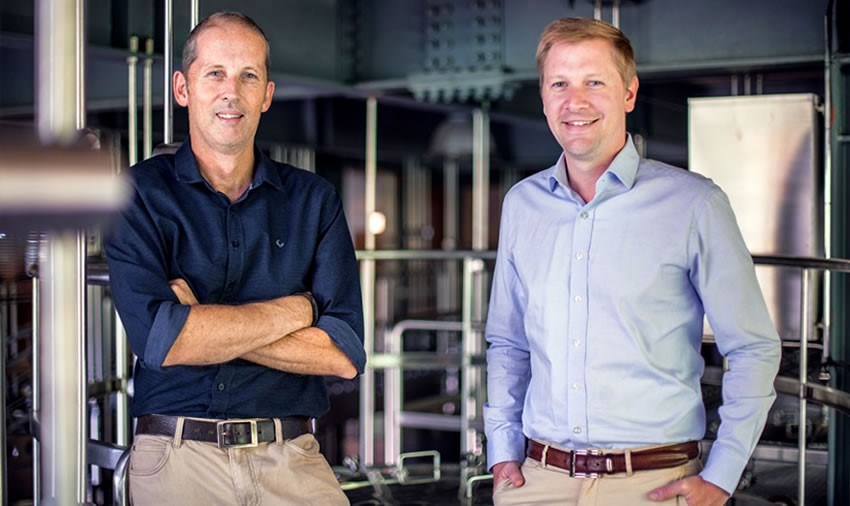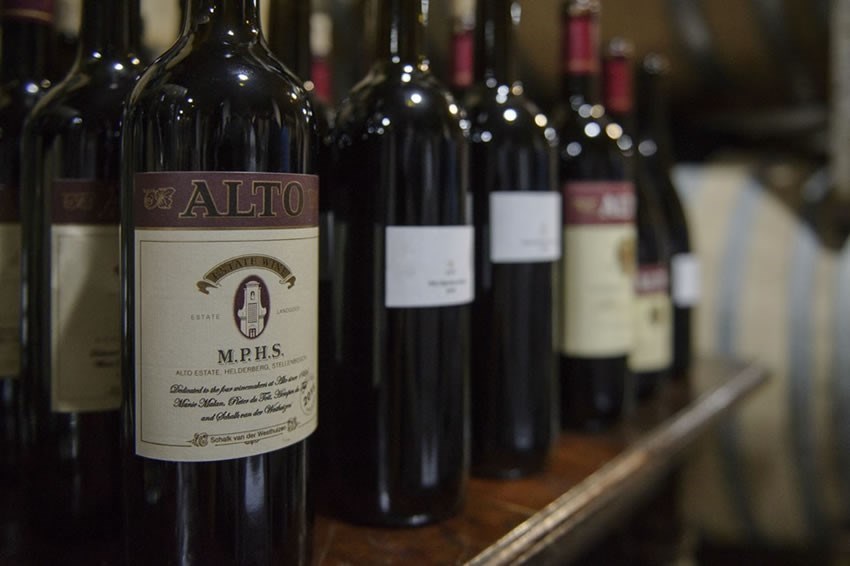It’s not often that Aristotle is debated at a wine tasting– but the occasion was the launch of Tokara’s new super-premium flagship, named Telos, after the Greek philosopher’s concept of the inherent purpose of every activity – the ultimate reason of each thing being the way it is. Telos, like Tokara, is the end-result of a goal-driven process – a new flagship wine which showcases Cabernet Sauvignon, the signature red variety of the estate’s viticulture, cellar and Stellenbosch wine region.
It’s not often either that I find myself in the neighbourly company of the boys of the Helshoogte ‘hood – sharing a table with the proprietors of Tokara (GT Ferreira), Rustenberg (Simon Barlow) and Gyles Webb (Thelema) and their spouses. GT Ferreira says, “Every farm has a sweet spot”, identified by viticulturist Aidan Morton who has spent two decades finding out which block produces the three best barrels of Cabernet which went into Telos 2016 – on a farm planted 65% to the hero variety. One of the smartest tastings of the year took guests through a series of food and wine pairings conducted in different parts of Tokara’s showpiece cellar by the architect, new winemaker Stuart Botha and GM Karl Lambour. Aristotle would love the aesthetics. The lunch created by new chef Carolize Coetzee was superb. Time flies – I attended the launch of the first vintage in the early 2000s.

Tokara viticulturist Aidan Morton and winemaker Stuart Botha
Across the road, media turned out to celebrate the tenth anniversary of Delaire Graff, a showcase for wine tourism in the Cape. Marking a decade at this iconic cellar, Morné Vrey has won acclaim for his elegant Chardonnay, Sauvignon Blanc, Cabernet Sauvignon and white and red Bordeaux blends. Delaire Graff head chef Kevin Grobler, who spent three years as head chef at the Michelin-starred Jan in Nice, France, prepared a fabulous food and wine pairing to celebrate the first ten years – showcasing sustainable organic produce and vegetables from the estate’s own edible gardens with wines from their vineyards, starring the award-winning Botmaskop Bordeaux-style blend and Banghoek Chardonnay Reserve. Seven of his wines are rated 4,5 stars in Platter’s 2019 Wine Guide.
Moving from one of the newest icons to one of the oldest SA wine brands, from Aristotle to Alto, I attended the centenary celebrations of a farm with a Latin name meaning altitude. One of the Cape’s oldest farms founded in 1693 granted by Governor van der Stel, wine was first made here in 1919. A gallery of the five winemakers who have made Alto Rouge over the last century gazed down at guests at the long lunch table in the cellar prepared by acclaimed chef Jacques Erasmus. Three father-and son teams have passed on the winemaking baton at Alto, Hennie and Manie Malan, Piet and Hempies du Toit, and Schalk (2001) and Bertho van der Westhuizen (2015). Each earned the delightful nickname under his portrait - Manie (the visionary), Piet (the perfectionist), springbok Hempies (the gentle heart), Schalk (the quiet crowd-pleaser) and incumbent Bertho (the reformer).
Like Tokara, Cabernet is also one of the focus varieties at Alto, a red wine specialist set high on the slopes of the Helderberg – a key component in the five-way assemblage of Alto Rouge with Cabernet Franc, Merlot, Petit Verdot and Shiraz –alongside the new signature Bordeaux blend and MPHS flagship bearing the initials of the first four winemakers.Sharing a winelands feast with Schalk and Bertho van der Westhuizen, we toasted Alto’s centenary celebration with a jeroboam of Alto Rouge 2012 – and later vintages of Cabernet Sauvignon, Shiraz and Alto Rouge paired with shared bowls of hearty consommé, roasted marrow bone pot au feu, braised short ribs, dumplings, and cheeses.

The seventieth anniversary of Roodeberg, another of the Cape’s pioneering dry red blends,was another milestone on this year’s wine calendar. KWV, which celebrated its centenary in 2018, marked the occasion with the launch of Roodeberg 1949, a new flagship blend of Cabernet, Tempranillo, Carignan and Carmenère. First released in 1949, the maiden Roodeberg blend was made from the 1946 vintage by legendary chief KWV winemaker Dr Charles Niehaus who took over from Dr Izak Perold – the pioneer who created Pinotage in 1925 by crossing Pinot Noir and Cinsault. Current KWV winemaker Louwritz Louw and viticulturist Marco Ventrella call themselves custodians of the brand, a heritage product, carrying on what others have done before. Making 2,5 million litres of Roodeberg – as well as the premium four expressions in the portfolio – is a daunting task.
Speaking at a lunch deep in the KWV cellar in Paarl, Louwritz declared “Roodeberg is a dedicated collaborative effort harnessing some of the finest plant material along with our combined viticultural and winemaking expertise. Roodeberg is all about understanding the varieties and regions we work with”. Made from grapes sourced from ten wine regions, from Darling, the Swartland and Paarl to Elgin, Bot River, Breedekloof and Robertson. Roodeberg is built around an oak-aged blend of Cabernet and Shiraz, blended with portions of Merlot, Petit Verdot, Tannat, Tempranillo, Carignan and Malbec. KWV chef Mynhardt Joubert created a traditional South African braai tray to match the big red anniversary – skilpadjies, chops, boerewors meatballs with tomato relish, sosaties, braai broodjie, slow-roasted springbok pie, koeksisters and melktert. Tradition runs deep around here.
Time waits for no man – so I’ll move onto the centenary of Middelvlei, another milestone in the Cape winelands in 2019. A nostalgic sepia portrait of Oupa Tinnie, who bought the farm for three thousand pounds in 1919, looked down on guests at a wine tasting led by two generations of the Mombergs, one of the first wine families of Stellenbosch. It’s the only wine tasting I’ve ever been to where chickens foraged for cracker crumbs around our feet under the table – the inspiration for the farm’s delightful new Rooster range of wines. The farms animals around here are as free-range as Middelvlei’s iconic Free-Run Pinotage made from their signature variety (Consumers in the Netherlands ask for Free-Range Pinotage too apparently!).Over a memorable tasting, we enjoyed vertical flights of Middelvlei’s hero Pinotage variety back to 1978, their pioneering Pinotage/Merlot blend (one of the first Cape blends) back to 1996, Shiraz and Cabernet Sauvignon back to 1989.
Authenticity and tradition make old family wine farms like Middelvlei a major tourist destination. In keeping with the homely spirit of the farm, they offer what they call a real boere braai. Jeanerette Momberg laughs, “The Middelvlei men can braai well as well as make very good wine. Tourists want a lifestyle experience at the cellar door. We never thought locals would pay another South African to braai! It is great exposure for the Middelvlei brand”. The daily 24/7 braai attracts 1000 visitors a week in season – and is a smorgasbord of South African delicacies from the farm jams and rooster-koek to the chops, boerewors, malva pudding and moer koffie. Cellar-door wine sales have boomed since the big braai was introduced in 2010 - and Middelvei is well set for a second century.